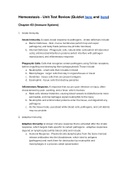Summary
SBI4U (AP Biology) - Homeostasis Summary/Test Review
- Course
- Biology
- Institution
- 12th Grade
This test review + free Quizlet summarizes the key concepts of homeostasis, as covered by the AP Biology/Ontario Grade 12 Biology curriculum. It deals with the immune, nervous, endocrine, and excretory system in 15 pages of detail!!
[Show more]



